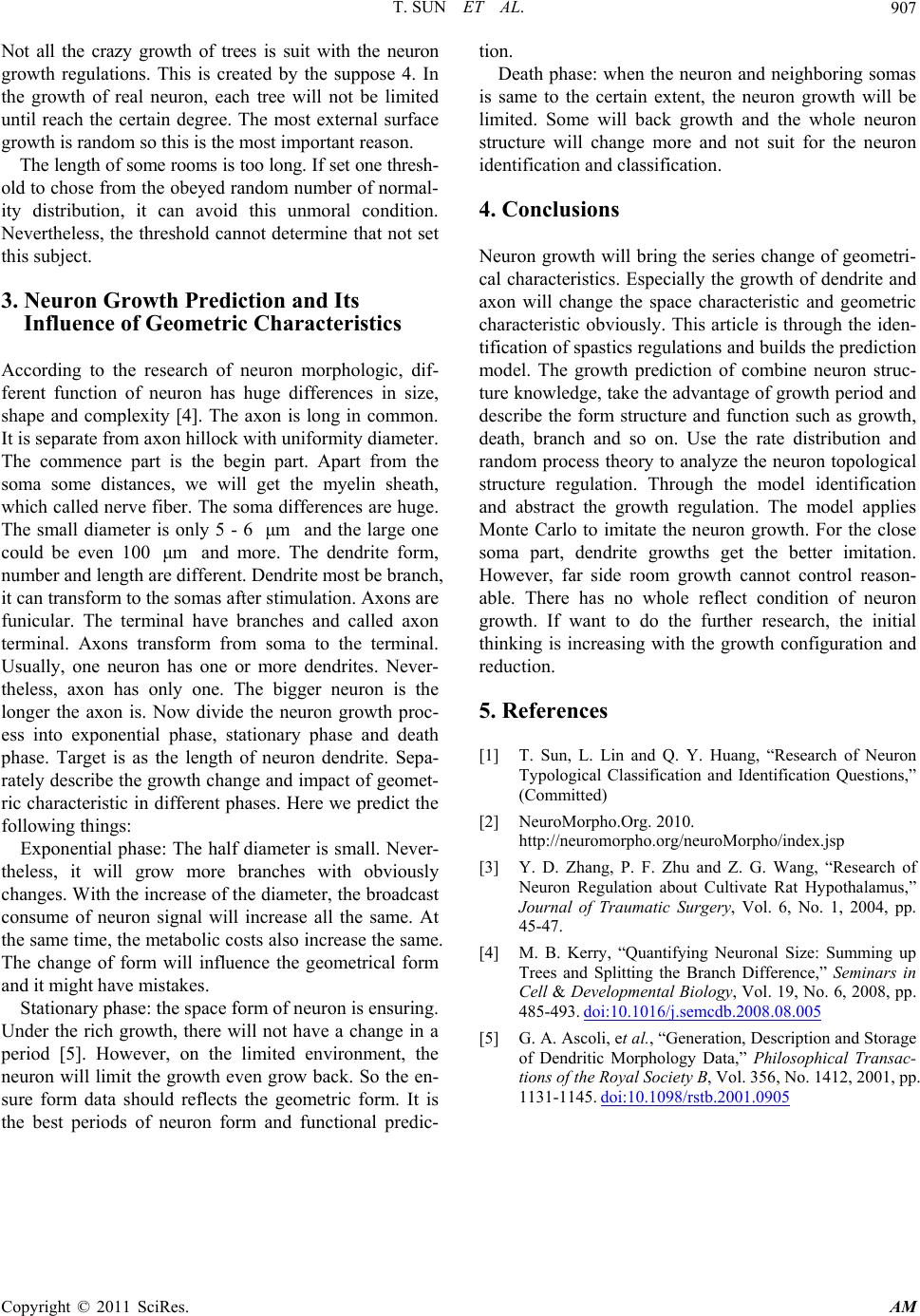
T. SUN ET AL.
Copyright © 2011 SciRes. AM
907
Not all the crazy growth of trees is suit with the neuron
growth regulations. This is created by the suppose 4. In
the growth of real neuron, each tree will not be limited
until reach the certain degree. The most external surface
growth is random so this is the most important reason.
The length of some rooms is too long. If set one thresh-
old to chose from the obeyed random number of normal-
ity distribution, it can avoid this unmoral condition.
Nevertheless, the threshold cannot determine that not set
this subject.
3. Neuron Growth Prediction and Its
Influence of Geome tric Characteristics
According to the research of neuron morphologic, dif-
ferent function of neuron has huge differences in size,
shape and complexity [4]. The axon is long in common.
It is separate from axon hillock with uniformity diameter.
The commence part is the begin part. Apart from the
soma some distances, we will get the myelin sheath,
which called nerve fiber. The soma differences are huge.
The small diameter is only 5 - 6 and the large one
could be even 100 and more. The dendrite form,
number and length are different. Dendrite most be branch,
it can transform to the somas after stimulation. Axons are
funicular. The terminal have branches and called axon
terminal. Axons transform from soma to the terminal.
Usually, one neuron has one or more dendrites. Never-
theless, axon has only one. The bigger neuron is the
longer the axon is. Now divide the neuron growth proc-
ess into exponential phase, stationary phase and death
phase. Target is as the length of neuron dendrite. Sepa-
rately describe the growth change and impact of geomet-
ric characteristic in different phases. Here we predict the
following things:
μm
μm
Exponential phase: The half diameter is small. Never-
theless, it will grow more branches with obviously
changes. With the increase of the diameter, the broadcast
consume of neuron signal will increase all the same. At
the same time, the metabolic costs also increase the same.
The change of form will influence the geometrical form
and it might have mistakes.
Stationary phase: the space form of neuron is ensuring.
Under the rich growth, there will not have a change in a
period [5]. However, on the limited environment, the
neuron will limit the growth even grow back. So the en-
sure form data should reflects the geometric form. It is
the best periods of neuron form and functional predic-
tion.
Death phase: when the neuron and neighboring somas
is same to the certain extent, the neuron growth will be
limited. Some will back growth and the whole neuron
structure will change more and not suit for the neuron
identification and classification.
4. Conclusions
Neuron growth will bring the series change of geometri-
cal characteristics. Especially the growth of dendrite and
axon will change the space characteristic and geometric
characteristic obviously. This article is through the iden-
tification of spastics regulations and builds the prediction
model. The growth prediction of combine neuron struc-
ture knowledge, take the advantage of growth period and
describe the form structure and function such as growth,
death, branch and so on. Use the rate distribution and
random process theory to analyze the neuron topological
structure regulation. Through the model identification
and abstract the growth regulation. The model applies
Monte Carlo to imitate the neuron growth. For the close
soma part, dendrite growths get the better imitation.
However, far side room growth cannot control reason-
able. There has no whole reflect condition of neuron
growth. If want to do the further research, the initial
thinking is increasing with the growth configuration and
reduction.
5. References
[1] T. Sun, L. Lin and Q. Y. Huang, “Research of Neuron
Typological Classification and Identification Questions,”
(Committed)
[2] NeuroMorpho.Org. 2010.
http://neuromorpho.org/neuroMorpho/index.jsp
[3] Y. D. Zhang, P. F. Zhu and Z. G. Wang, “Research of
Neuron Regulation about Cultivate Rat Hypothalamus,”
Journal of Traumatic Surgery, Vol. 6, No. 1, 2004, pp.
45-47.
[4] M. B. Kerry, “Quantifying Neuronal Size: Summing up
Trees and Splitting the Branch Difference,” Seminars in
Cell & Developmental Biology, Vol. 19, No. 6, 2008, pp.
485-493. doi:10.1016/j.semcdb.2008.08.005
[5] G. A. Ascoli, et al., “Generation, Description and Storage
of Dendritic Morphology Data,” Philosophical Transac-
tions of the Royal Society B, Vol. 356, No. 1412, 2001, pp.
1131-1145. doi:10.1098/rstb.2001.0905